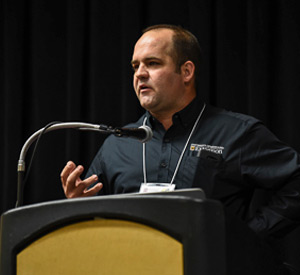Reprinted courtesy of ARSBC Newsroom
Some people just don’t trust EPDs. The acronym EPD stands for “expected progeny difference” — a numerical value that represents a prediction of the average performance, relative to a specific trait, among the progeny of a breeding animal. To aid genetic selection, EPDs are used to compare the expected performance of one sire’s calves with those of another sire’s.
“But some people are suspicious. They think someone is pulling strings to manipulate the numbers,” lamented animal geneticist Jared Decker while addressing a New Mexico gathering of cattle folk. “But EPDs work. They absolutely work.”
A researcher and assistant professor at the University of Missouri, Decker returned to his native New Mexico to speak during the Applied Reproductive Strategies in Beef Cattle Workshop hosted Aug. 29-30 in Ruidoso. He talked about the value of using EPDs to achieve genetic improvement over the long haul.
 |
| “EPDs work. They absolutely work,” said Jared Decker, University of Missouri. |
Decker discussed how EPD-aided selection can work for a cow-calf production system utilizing crossbreeding, even though EPDs are breed-specific. He advised cattlemen to use breed effects and breed complementarity to choose the breeds suitable to their environment and production system. Then EPDs can be applied to selection of individuals from each breed.
Reminding the audience that EPDs are not a substitute for phenotypic evaluation, Decker emphasized the need for visual appraisal of skeletal structure and soundness. He added, however, that some breed associations have introduced new EPDs for certain structural characteristics, such as
foot angle and udder and teat structure, with more selection tools of this kind expected in the future.
A criticism of EPD use is that it leads to selection for maximum expression of traits, and Decker admitted that it has happened.
“EPDs are just a tool, and it matters how you use them,” Decker said, noting how unbridled selection for higher milk production and increased calf performance can lead to a breeding herd with bigger mature size, higher nutrient requirements, reduced reproductive rates and increased costs of production.
According to Decker, rather than focusing on one or a very few traits, producers should practice multiple-trait selection. He advocated use of selection indices suited to a producer’s respective operation and marketing goals. Whether the goal is to keep replacement females or sell all calves — to market calves at weaning, as yearlings or as fed cattle —there is an index that combines various appropriate and economically weighted trait EPDs into a single value that can be used to aid genetic selection for optimal trait expression.
If there is a shortcoming to EPDs and selection indices, it may be that they do not take into account the variations, by geographic region, in climate and other environmental stressors. Decker said two USDA-funded research projects are investigating selection with consideration of environmental stressors. The goal of one project, led by the University of Missouri, is to prototype environmental region-specific EPDs. This would allow selection of genetics that match the production environment. Until such time as this kind of tool is available, Decker advises producers to source seedstock from environments similar to their own.
Decker said some of the blame for mistrust of technology like EPDs, falls to academia and industry professionals for not presenting them and their proper use in ways that are more clearly understood. However, EPDs are no longer a new technology, and independent-minded producers need to realize how application of EPDs for genetic selection can enhance the success and sustainability of their operations.
“Do it for your children and your grandchildren,” advised Decker.
For details on Decker’s presentation — including the proceedings, PowerPoint and video of his presentation — visit the Newsroom at
www.appliedreprostrategies.com.




Comments
Via Email : chiefdrlucky@gmail.com
Thank you all for reading,
God bless"